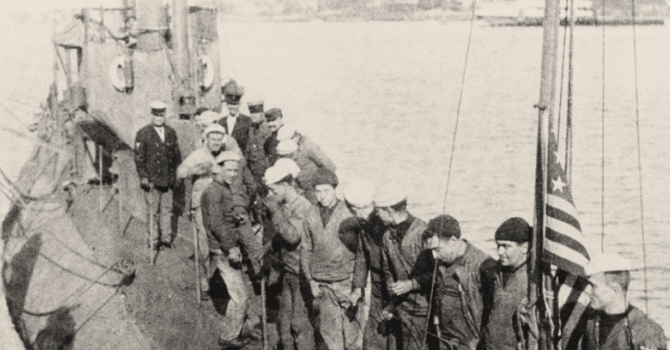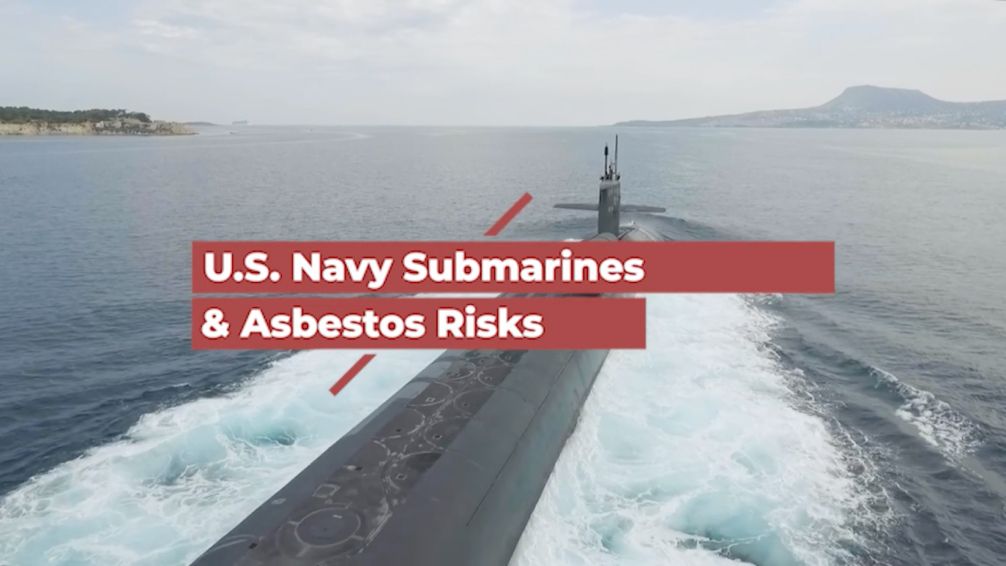The U.S. Navy used asbestos products in all of its submarines for decades. In total, nearly 400 submarines are known to have contained asbestos. Any Navy veteran exposed to asbestos on submarines is at risk of developing a deadly cancer called mesothelioma. We can help veterans with mesothelioma and their loved ones pursue VA benefits, health care, and legal compensation.
Is There Asbestos on Submarines?
Yes, there was asbestos on virtually all U.S. Navy submarines from 1922 through the early 1980s.
Asbestos-containing products like insulation, gaskets, and valves were used to keep submarines fireproof and durable. However, Navy personnel could develop mesothelioma later in life if they were exposed to asbestos on submarines.
Video Summary: Almost 400 Navy submarines were built with asbestos, a material that causes mesothelioma. Get help if you served on a submarine and now have this cancer by calling (877) 450-8973. View Transcript
As early as World War I, the U.S. Navy relied on a substance called asbestos when building submarines.
Asbestos is a very durable mineral that can cheaply be used as insulation aboard Navy submarines and other vessels in pipes, insulation, flanges, and more.
Nearly Over 400 U.S. Navy submarines and thousands of other Navy ships were built with asbestos due to government mandates.
But, asbestos exposure can cause a fatal cancer known as mesothelioma decades later. One-third of all mesothelioma cases can be linked back to Navy service. There’s no cure for mesothelioma, and the prognosis is often poor.
Thankfully, U.S. Navy veterans who have mesothelioma after serving aboard submarines can access a wealth of medical and financial resources.
Some of the most crucial benefits are offered by the U.S. Department of Veterans Affairs, including monthly disability payouts, free or low-cost mesothelioma treatments, and financial support for the veteran’s family members.
Additionally, veterans can also file private claims against the makers of asbestos-containing products. These claims may award additional compensation without affecting the veteran’s ability to file for VA benefits.
The Mesothelioma Veterans Center is proud to help veterans and families who’ve been impacted by this aggressive cancer obtain the justice they deserve. Reach out to us today to get started.
If you or a loved one has mesothelioma that stems from asbestos on submarines or other U.S. Navy ships, we may be able to help.
The Mesothelioma Veterans Center can connect you with benefits from the U.S. Department of Veterans Affairs (VA), cancer treatments, and legal compensation if eligible. Get started with our Free Veterans Packet.
List of U.S. Navy Submarines With Asbestos
Almost 400 U.S. Navy submarines were built with asbestos. This was before the mineral was known to cause mesothelioma, as manufacturers of asbestos products hid the risks from the public for decades.
U.S. Navy submarines with asbestos include:
- USS Albacore
- USS Atlanta
- USS Argonaut
- USS Balao
- USS Baltimore
- USS Baton Rouge
- USS Birmingham
- USS Boston
- USS Bremerton
- USS Cavalla
- USS Cincinnati
- USS Dallas
- USS Glenard P. Lipscomb
- USS Groton
- USS Houston
- USS Indianapolis
- USS Jacksonville
- USS L. Mendel Rivers
- USS La Jolla
- USS Los Angeles
- USS Memphis
- USS Michigan
- USS New York City
- USS Nautilus
- USS Omaha
- USS Parche
- USS Pompon
- USS Pollack
- USS Richard B. Russell
- USS Runner
- USS San Francisco
- USS Seawolf
- USS Tench
- USS Tunny
- USS Will Rogers
- USS William H. Bates
Please note that this is only a partial list of U.S. Navy submarines that contained asbestos. You may have been exposed even if your submarine isn’t listed above.
Further, thousands of other U.S. Navy ships were built with asbestos, putting millions of service members at risk of mesothelioma.
U.S. Navy Submarine Jobs and Asbestos Dangers
Any U.S. Navy veteran who served on submarines before the 1980s may have been exposed to asbestos products. However, certain jobs carried a greater risk of exposure to asbestos on submarines.
Jobs with a high risk of asbestos exposure included:
- Boiler room workers
- Electricians
- Engine room workers
- Machinists
- Pipefitters
- Plumbers
- Shipyard workers
- Welders
These Navy service members may have installed, repaired, or replaced asbestos products on a daily basis.
During these tasks, asbestos fibers could be released into the air, putting workers at risk of breathing in or swallowing the fibers.
After 10-50 years, those exposed to asbestos could develop mesothelioma or another asbestos-related illness. This means veterans exposed to asbestos on submarines decades ago are still at risk today.
Products Made With Asbestos on Submarines


Asbestos materials were used in Navy submarines to help reduce the risks of fires, which could have been catastrophic if one started while the vessel was underwater.
Asbestos products on U.S. Navy submarines included:
- Gaskets
- Flanges
- Insulation
- Packing materials
- Piping
- Seals
- Tape
- Valves
- Water pipes
- Wire cloth
Navy sailors working with any of these products could have been exposed to microscopic asbestos fibers.
Since submarines were cramped and poorly ventilated — especially when underwater — asbestos fibers could linger in the air for hours at a time. This put anyone serving on submarines at risk of exposure and mesothelioma later in life.
Find out how to get VA benefits, treatments, and compensation if you developed mesothelioma from Navy submarines in our Free Veterans Packet.
Compensation Options for Asbestos Exposure on Submarines
If you were exposed to asbestos on submarines and now have mesothelioma, you may qualify for VA benefits and legal compensation.
In fact, you may be eligible for $1 million or more after a mesothelioma diagnosis, which can help keep you and your family financially secure for years to come.
Learn more about your mesothelioma compensation options below.
Submarine Veterans Disability Benefits
You may qualify for financial compensation as part of your mesothelioma VA benefits package.
Mesothelioma is considered a 100% disability, and veterans with this cancer typically get [reusable-data id="25648" label="General VA Benefit Number"] per month through VA disability for 2024. Our team can help you start your VA claim today.
Other VA benefits include free or low-cost mesothelioma treatments from VA doctors, financial aid for next of kin, and other financial resources.
Mesothelioma Lawsuits
Our partner law firm can help you file a mesothelioma lawsuit against the companies that made the asbestos-based products you were exposed to.
These lawsuits typically award $1 million or more. You can still get VA benefits after filing a lawsuit, and no legal action is taken against the U.S. military or government.
Past mesothelioma submarine lawsuits have awarded:
Find a mesothelioma lawyer right now who can help file a lawsuit on your behalf and secure strong payouts if you're eligible.
Asbestos Trust Funds
Many asbestos companies filed for bankruptcy to avoid being sued, but these companies were forced to set aside money in trust funds to help victims. As of 2024, there’s over $30 billion still available across all asbestos trust funds.
You may qualify to file asbestos trust fund claims and access some of this compensation, depending on which products you were exposed to.
We have attorneys on staff who can help you pursue VA benefits and asbestos trust fund claims at the same time. Get help filing trust fund claims now.
History of Mesothelioma and Navy Submarines


The use of asbestos on submarines continued through World War II, the Korean War, and the Vietnam War.
Many types of submarines relied on asbestos, including:
- Attack submarines (SSK)
- Ballistic missile submarines (SSBN)
- Guided missile submarines (SSGN)
- Nuclear-powered submarines (SSN)
- Radar picket submarines (SSR)
When it was revealed that manufacturers of asbestos products had hidden the deadly health risks, major renovation projects began to remove asbestos from submarines and other Navy ships.
Today, no Navy submarines contain asbestos — but thousands of veterans now have mesothelioma from being exposed before the dangers of asbestos were known.
Did you get sick from asbestos on submarines? You may be eligible for VA benefits, medical care, and legal compensation. Call (877) 450-8973 to learn more.
We Can Help U.S. Navy Veterans With Mesothelioma
If you or a loved one served on a U.S. Navy submarine and now has mesothelioma, the Mesothelioma Veterans Center may be able to help you.
Since our founding, thousands of veterans and their families have put their trust in our experienced team — which includes mesothelioma nurses, VA-accredited agents, and lawyers — to get compensation and justice.
If eligible, you can work with our team to access:
- VA benefits worth almost $4,000 a month
- Cancer treatments from top VA doctors and hospitals
- Lawsuit payouts typically valued at over $1 million
- Trust fund compensation
- Other key resources that can help you and your family.
Get a Free Veterans Packet or call (877) 450-8973 now to find out all the ways we can assist you if you have mesothelioma from Navy submarines.
Asbestos on Submarines FAQs
What are the health issues with submariners?
Any U.S. Navy submariner could develop mesothelioma, lung cancer, asbestosis, or other diseases if they were exposed to asbestos.
Asbestos is a toxic substance that was used aboard every Navy submarine from 1922 until the early 1980s.
Asbestos-related diseases like mesothelioma take 10-50 years to develop, so Navy submariners exposed to asbestos decades ago are still at risk today.
What was asbestos used for in the Navy?
The U.S. Navy used asbestos on submarines since this material was heat resistant, very durable, and not corrosive.
Further, the deadly dangers of asbestos weren't fully known to the general public until the early 1980s, so Navy personnel thought it was safe for decades.
Is there still asbestos on Navy ships?
There are still asbestos-containing products on a handful of older U.S. Navy ships.
However, no U.S. Navy submarines that are currently in use contain asbestos, according to a 2024 review of the Naval Vessel Register.
Further, the asbestos products on older ships are sturdy and in good shape, meaning they don’t pose a threat to human health.
Does the military still use asbestos?
The vast majority of military assets do not contain asbestos.
Asbestos is only found in a small percentage of older ships and buildings where it wasn’t practical to remove the products in question.
The military no longer uses asbestos when constructing new submarines, other ships, or buildings.



